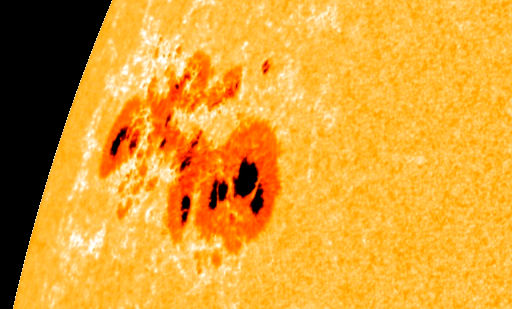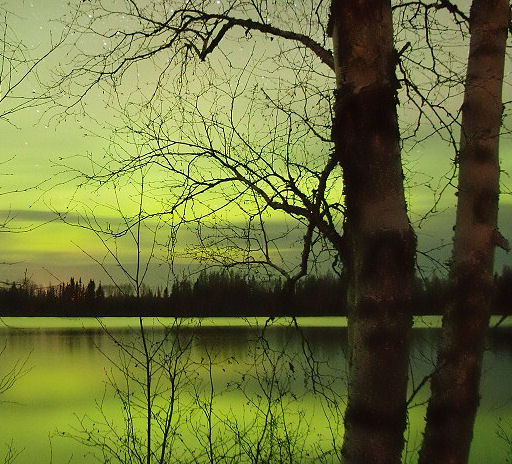Metallic photos of the sun by renowned photographer Greg Piepol bring together the best of art and science. Buy one or a whole set. They make a stellar gift. | | |
X-FLARE: Earth-orbiting satellites have just detected an X2-class solar flare. The source is huge sunspot AR1339, described below. Stay tuned for updates. Solar flare alerts: text, voice.
SPACE DOCKING--UPDATE: The unmanned Shenzhou 8 spacecraft docked with China's new space station, the Tiangong 1, on Nov. 2nd. It was the first-ever docking maneuver for China's rapidly growing space program and hailed by authorities as an important milestone. Just before docking, Bryan Murahashi saw the two spacecraft flying together over San Jose, California: "They were easy to see high in the morning sky," he says. The two spacecraft will separate again in mid-November for more maneuvers. Check the Satellite Tracker or your smartphone for local flyby times.
MAGNIFICENT SUNSPOT: One of the largest sunspots in years is rotating over the sun's northeastern limb. NASA's Solar Dynamics Observatory took this picture of AR1339 during the early hours of Nov. 3rd:

Measuring some 40,000 km wide and at least twice that in length, the sprawling sunspot group is an easy target for backyard solar telescopes. Two or three of the sunspot's dark cores are wider than Earth itself.
Naturally, such a large sunspot has potential for strong flares. NOAA forecasters estimate a 50% chance of M-class solar flares during the next 24 hours. One such eruption has already occured: An M4-flare at 2200 UT on Nov. 2nd produced a bright flash of extreme UV radiation (SDO movie) and hurled a coronal mass ejection (CME) into space. The CME is not heading our way. Future CMEs could have greater effect as AR1339 turns toward Earth in the days ahead. Solar flare alerts: text, voice.
NORTHERN LIGHTS: November began with a geomagnetic storm. A shock wave in the solar wind swept past Earth during the early hours of Nov 1st, sparking strong magnetic disturbances around the Arctic Circle. Paul Beebe sends this report from Upsala, Canada: "I awoke around 6:30 am and saw auroras out my bedroom window. They were dancing like green flames in the northern sky, with the occasional spike of pink or red barely visible." He quickly dressed and headed to the shores of nearby Lang Lake for this shot:

More auroras are possible on Nov. 4th. A coronal mass ejection (CME) left the sun on Oct. 31st when a solar filament erupted; the cloud could deliver a glancing blow to Earth's magnetic field this Thursday. Aurora alerts: text, voice.
October 2011 Aurora Gallery
[previous Octobers: 2010, 2009, 2008, 2007, 2006, 2004, 2003, 2002]
Potentially Hazardous Asteroids (
PHAs) are space rocks larger than approximately 100m that can come closer to Earth than 0.05 AU. None of the known PHAs is on a collision course with our planet, although astronomers are finding
new ones all the time.
On November 3, 2011 there were 1256 potentially hazardous asteroids.
Notes: LD means "Lunar Distance." 1 LD = 384,401 km, the distance between Earth and the Moon. 1 LD also equals 0.00256 AU. MAG is the visual magnitude of the asteroid on the date of closest approach. | | The official U.S. government space weather bureau |
| | The first place to look for information about sundogs, pillars, rainbows and related phenomena. |
| | Researchers call it a "Hubble for the sun." SDO is the most advanced solar observatory ever. |
| | 3D views of the sun from NASA's Solar and Terrestrial Relations Observatory |
| | Realtime and archival images of the Sun from SOHO. |
| | from the NOAA Space Environment Center |
| | the underlying science of space weather |
| | for out-of-this-world printing and graphics |

